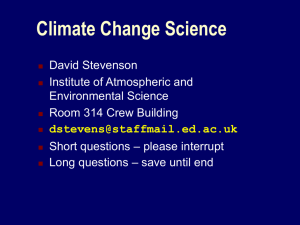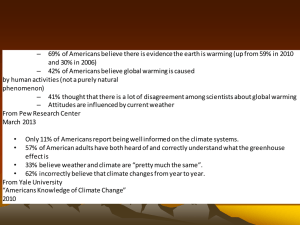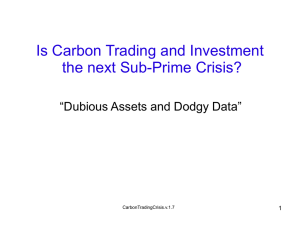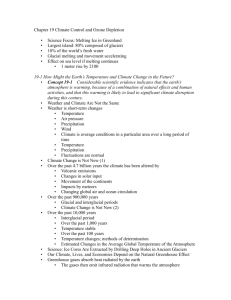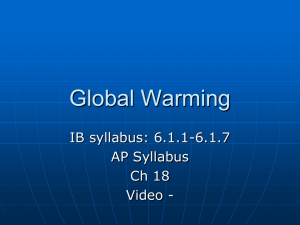Environmental Science
advertisement
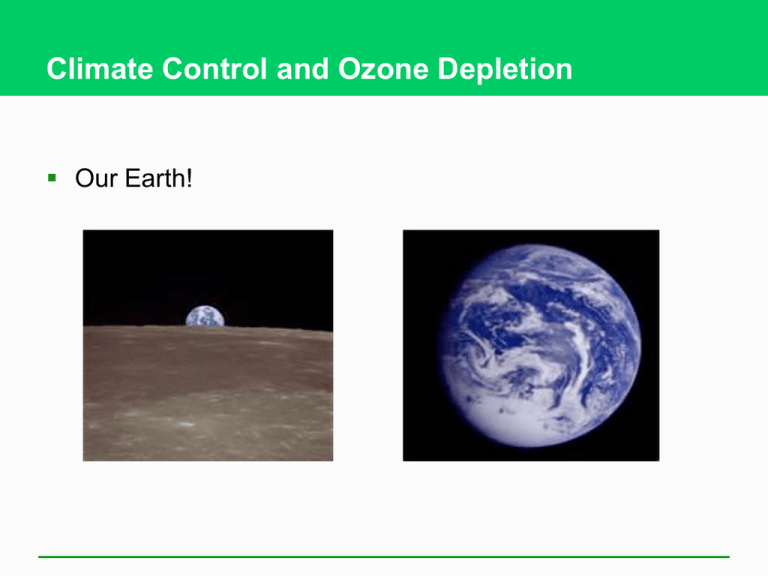
Climate Control and Ozone Depletion Our Earth! An Enormous Cloud of Air Pollutants and Ash from Mt. Pinatubo on June 12, 1991 Volcanoes Change Worldwide Climate Mount Pinatubo exploded releasing airborne pollutants and ash resulting in deaths and damage of farmlands and homes Volcanoes affect worldwide temperature by cooling (clouds); after the pollutants leave, temperatures return to normal (remember the Iceland volcano that halted planes for a week) Climate will change because of the release of the volcanic gases – Year without summer in the 1816 – 1815 eruption of Mount Tambora in the Dutch East Indies (Indonesia), the largest known eruption in over 1,300 years Climatic models indicate that global temperatures will rise because of greenhouse gasses affecting climate and the human way of life Primary question: “What should we do about it?” Global Warming and Global Cooling Are Not New Over the past 4.7 billion years the climate has been altered by: volcanic emissions; changes in solar input; movement of continents; and impacts by meteors Over the past 900,000 years: Earth has experienced prolonged periods of Global Cooling and Global Warming; these alternating freezing and thawing cycles are Glacial and Interglacial (between ice ages) periods Over the past 10,000 years: Earth is in an Interglacial Period of fairly stable climates and roughly the same temperatures; this allowed agriculture, cities and the human population to flourish Over the past 1,000 years: temperatures have remained stable except for the past century when we started to remove more forest and burn fossil fuel increasing global temperatures Estimated Changes in the Average Global Temperature of the Atmosphere Human Activities Emit Large Quantities of Greenhouses Gases Without the Natural Greenhouse Effect (Ozone Layer) which warms the lower atmosphere and surface, the Earth would be a cold and uninhabitable earth Since the Industrial Revolution: • Greenhouse Gasses: CO2, CH4, and N2O increased • Main Sources: agriculture, deforestation, and burning of fossil fuels Correlation of Rising CO2 and CH4 with rising global temperatures during the past 400,000 years and the rising of the global sea level Countries with the largest CO2 emissions: US, China, European Union (with 27 countries), Indonesia, Russia, Japan and India; with the US responsible for 25% of the world’s cumulative emissions, China 5% Atmospheric Levels of CO2 and CH4, Global Temperatures, and Sea Levels The Atmosphere Is Warming Mostly Because of Human Activities Intergovernmental Panel on Climate Change (IPCC) • Includes 2500 climate expects from 130 nations • Its 2007 report is based on 29,000 pieces of data since 2002: • • • • • • • 90–99% likely that lower atmosphere is warming 1906–2005: Ave. temp increased about 0.74˚C (1.3 F); greatest since 1980 1970–2005: Annual greenhouse emissions up 70%; carbon dioxide levels are higher than in 650,000 years Past 50 years: Arctic temp rising almost twice as fast as the rest of the earth Melting of glaciers and floating sea ice (Arctic Ocean) Prolonged droughts; changing rain patterns Last 100 years: sea levels rose 10–20 cm (4-8 inches) Melting of Alaska’s Muir Glacier between 1948 and 2004 Can the Oceans Save Us? Oceans Absorb CO2 (25-30%); but the solubility of CO2 in ocean water decreases with increasing temperature Bad News: Warmer Oceans: • CO2 levels increasing acidity – example is carbonic acid in sodas • As the oceans are not absorbing as much CO2, this further accelerates global warming by increasing atmospheric CO2 • Effects coral reefs – acid prevents them from making shells (calcium carbonate) As Antarctica’s Southern Ocean and the North Atlantic Ocean warms: • Largest sink for removing it – further decreasing in CO2 • Significance on global CO2 levels needs to be established Good News: Atlantic Deep Ocean has increased productivity by 15%; phytoplankton may be increasing due to the warmer waters The inability of the oceans to absorb carbon dioxide can intensify and accelerate global warming and climate change. Enhanced Global Warming Could Have Severe Consequences Not concerned with normal swings in daily weather, but in the projected, very rapid, global change in climate – decades, centuries or millennia from now – How rapidly will it change? Key Problem: projected rapid increase in the average temperature during this century – we don’t know the answer? Tipping Point: When will it be too late to reverse changes that result from climate change? Worst-Case Scenarios: • Ecosystems collapsing • Low-lying cities flooded • Wildfires in forests • Prolonged droughts: grasslands become dust bowls • More destructive storms • Glaciers shrinking; rivers drying up Projected Effects of Global Warming and the Resulting Changes in Global Climate Severe Drought Is Increasing: The Browning of the Earth Drought • Occurs when evaporation from increasing temperatures exceeds precipitation for a long period • Areas of severe drought has increased from about 15% to 30% - total area the size of Asia from 1979 to 2002 Less Moisture in the Soil: • Steam flow and available surface water declines can result in drought • Less vegetation and net productivity and biodiversity will decrease Dry Climate Ecosystems Increase: • Savannas, chaparrals, deserts Other Effects: • Fires • Food shortages • Mass migrations and deaths (not only of people but animals, plants and other organisms) Ice and Snow Are Melting Polar Regions help to cool the Earth: • Light color ice and snow help to reflect the sun’s energy • Melting exposes darker surfaces increasing absorbance of solar energy – driveway in snow • Polar regions will melt quicker, exposing more land, etc • Can result in a runaway positive feedback loop Losing Ice in both mountain glaciers and polar ice caps Important Climate Role of Sea Ice: • Lose can result in changing precipitation patterns (less in US, more in Europe) • Floating sea ice does not contribute to rising waters but land base Arctic ice that melts will Mountain Glaciers Affected By: • Average snowfall and warm temperatures; as the melt, they provide fresh water but what will occur after they have melt? • Also, releasing fresh water into the oceans, what affect will that have? The Big Melt: Some of the Floating Sea Ice in the Arctic Sea Areas of Glacial Ice Melting in Greenland during Summer 1982–2007 Increased Sea Levels Are Rising The World’s Sea Levels are very likely to: • Rise 0.6-1.9 ft during this century and continue to rise • About 2/3’s will result from the expansion of warm water and 1/3 from land based ice (glaciers) • Others suggest 3.3-6.6 ft; and if glaciers in Greenland rich a tipping point, 20 ft. Projected Irreversible Effect: • Degradation and loss of 1/3 of coastal estuaries, wetlands, and coral reefs • Disruption of coastal fisheries • Flooding of • Low-lying barrier islands and coastal areas (US East, Gulf coast; states most affected – LA, FL, NC, TX and SC (sand hills?)) • Agricultural lowlands and deltas where rice is grown • Contamination of freshwater aquifers from salt and brackish water – water supplies, irrigation, drinking • Submergence of low-lying islands in the Pacific and Indian Oceans and the Caribbean (1 in 20 people) • Flooding of coastal cities and displacement of at least 100 mil people NYC Under Water NYC Under Water! Areas of Florida, U.S., to Flood If Average Sea Level Rises by One Meter Projected Decline in Arctic Tundra in Portions of Russia from 2004 to 2100 Ocean Currents Are Changing but the Threat Is Unknown Shallow and Deep Ocean Currents: Connected and move like a giant conveyer belt transferring warm and cold water between the surface and the deeps and from the tropics to the poles Melting glaciers (Greenland), can add fresh water to the oceans as can increased rain in the North Atlantic Will the fresh water disrupt the currents? What affect would this then have on climates (ocean biodiversity)? Not thought to be an immediate problem on the ocean currents but more research is needed Extreme Weather Will Increase in Some Areas Extreme Weather: • Such as heat waves and droughts in some areas will increase killing large numbers of people, reduce crop production and expand deserts • Prolonged rains and flooding in other areas • Will storms get worse? Not known • Hurricanes: warmer water will fuel them but also increased wind shear in the Atlantic may inhibit Global Warming Is a Major Threat to Biodiversity Changes in Climate from Global Warming is affecting physical and biological ecosystems on all continents; a warmer climate can expand the habitat of many including weeds, insect pest like fire ants, and other disease carrying organisms 30% of the land and animal based Species Can Disappear if the chance exceeds 2.5-4.5 F; 70% if 6.3 F; hardest hit is the colder climates (polar bear, penguins) Also, disrupt the Biological Clocks of Birds, whales and other migratory species; wrong place at the wrong time Most Susceptible Ecosystems: coral reefs; polar seas; coastal wetland; high-elevation mountaintops; and alpine and arctic tundra Forest may not be able to move quick enough: Arctic forests will decline but the oaks may be able to move quickly and expand northward Which Organisms Could Increase with global warming? Significance? Insects (pine beetles); Fungi and Microbes Exploding Populations of Mountain Pine Beetles in British Columbia, Canada Climate Change Will Shift Areas Where Crops Can Be Grown Farming more than any other activity depends on a stable environment; drastic changes may occur do to shifting climates and a faster hydrologic cycle Regions of Agricultural Productivity (farming) may shift: • Decrease in tropical and subtropical areas • Increase in northern latitudes if temps rise 1.8-5.5 F • Less productivity (less food); soil not as fertile There could be a 10-15% drop in rainfall in the US and other parts of the world; it is hoped that Genetically Engineered Varieties of key food crops could be developed that are more tolerant to drought and “climate” Food Production could decline along rivers fed by snow; arid and semiarid areas where drought will increase; and humid areas (SE Asia – monsoons) Food May Be Plentiful because of longer growing seasons in the northern regions but by 2050, 200-600 mil of the world’s poorest and most vulnerable can face starvation and malnutrition What Are Our Options? Addressing climate change could be one of the most urgent scientific, political, economic and ethical issues we face: Global Problem: international cooperation • • Long-lasting effects: climate changes due to excessive greenhouse gasses will last hundreds to thousands of years Long-term political problem not short term; most of the people that will suffer the most harm haven’t been born yet Two Approaches: most agree it’s a combination of both: • Drastically Reduce the Amount of Greenhouse Gas Emissions to slow down the rate of warming in time to prevent global climate changes • Recognize that Some Aspects are Unavoidable and to devise strategies to reduce the harmful effects Will we reach a Political Tipping Point when enough individuals exert sufficient political and consumer pressure (through their purchases) to their politicians and business leaders before we reach irreversible Climate Change Tipping Points? Solutions: Global Warming, Methods for Slowing Atmospheric Warming Fifteen Ways to Cut CO2 Emissions Governments Can Enter into International Climate Negotiations: The Kyoto Protocol 1997: 161 nations meant to negotiate a treaty to slow climate change; into effect in 2/05 with 174 of 194 countries (not the US) ratifying the agreement The Kyoto Protocol: • Reduce emissions of CO2, CH4, and N2O to at least 5.2% below their levels of 1990 by 2012 of 36 participating developed countries; developing nations were excluded as this may hinder economic growth including China and India • Trading greenhouse gas emissions among countries; plant trees if you are emitting greenhouse gases; but this didn’t work as it may actually encourage emissions • Not signed by US: Bush’s reasons: harm the US economy; did not require developing nations as China or India to reduce theirs • Most analysts and 59% of the Americans in a 1997 poll stated we should use our influence to improve the treaty rather than weaken and abandon it Some Governments Are Leading the Way Costa Rica: goal to be Carbon Neutral by cutting its net carbon emissions to zero by 2030; generates 78% of its power with renewable hydroelectric power and another from 15% from wind and geothermal Norway: aims to be carbon neutral by 2050 China and India • Must change energy habits by “leapfrogging” over traditional forms of economic development such as coal burning and become leaders in designing, manufacturing and selling cleaner power systems, appliances, cars and homes • “Green Technologies” will make up most of the future industries U.S. cities and states taking initiatives to reduce carbon emissions – solar and wind power, bicycles trails, mass transit What Can You Do? Reducing CO2 Emissions Ways to Prepare for the Possible LongTerm Harmful Effects of Climate Change Ozone Layer Ozone in the lower stratosphere keeps 95% of the sun’s harmful UV-rays (UV-A, UV-B) from hitting the Earth Ozone Thinning (Ozone Hole): • 40-50% seasonal depletion in the stratosphere in Antarctica and Arctic (some up to 100%); thinning in other regions except the tropics; worst between 2010-2019 • When the seasonal thinning ends, huge masses of ozone move and they linger over Australia, New Zealand, Africa and South America; increasing UV-B levels by 3-10% • Similar hole in the Arctic from Feb to June; 11-38% • Thinning can cause a serious threat humans, animals and plants (producers) that use sunlight to support food webs • CFC (chlorofluorcarbon); Freons; dream chemicals; coolants; propellants in aerosol spray cans and fumigants responsible for 75-85% of depleted O3 Good News: in 60–100 years, the ozone layer will return to pre-1950 levels (possibly by 2068) Natural Capital Degradation: Massive Ozone Thinning over Antarctica in 2007 Natural Capital Degradation: Effects of Ozone Depletion




